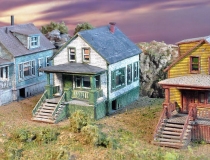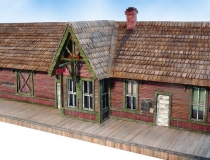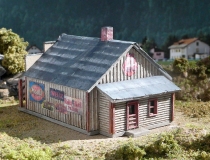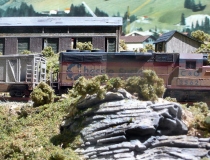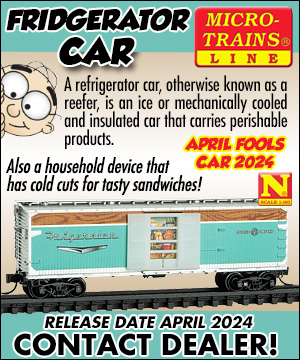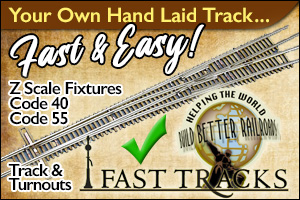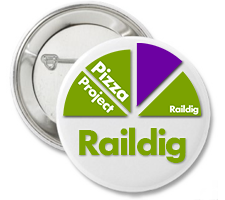Bob Mitchell
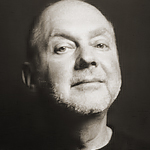 Many of our readers will recognize your name from your product builds and reviews in Ztrack Magazine, how about a little background information? Who exactly is Bob Mitchell?
Many of our readers will recognize your name from your product builds and reviews in Ztrack Magazine, how about a little background information? Who exactly is Bob Mitchell?
I’m freshly retired from 35 years as a High School photography and art teacher, a career I really loved, and have been a professional (albeit analog!) photographer. I have had a wonderful adventure in the NY art world where combining large-format Polaroid Transfer image-making with my models as subject led to a pre-9/11 “career.” I’ve been fortunate to have exhibited in major museums and galleries.
My older brothers, one of whom had a Lionel layout, the other a very competent plastic model-builder, influenced me and I had an HO layout as a teen before the typical discovery of cars and women. Currently I’m happy to report I’m still very interested in all three but I have no layout at present.
I’m also president of my local radio control flying club and that’s a fairly new vice. Many innovations in flying models are concurrent with model railroading such as the digital and electronic advances and regrettably, the proliferation of already-built ready-to-run equipment. Not enough people are building their models, in both hobbies!
Your name and your work appear on lots of websites, from FOS Scale Models to CC Crow and more. Much of your work seems to be in HO scale, what attracted you to Z scale?
Each scale has its own challenges and the realities of scale modeling presents problems to be solved in each scale. What may be feasible in G Gauge, like modeling, say, a hammer, is impossible in Z where an automobile is hard to make believable. I was attracted to just that, the challenge of building a model in Z that shows the realistic ravages of time and possesses the character and realism of the prototype. Everything is a compromise and for me, the compromises in 1:220 are perhaps more profound, and therefore more fun to try to master.
Lajos Thek’s SW-1 switcher kit and Robert Ray’s wood caboose kits are in themselves kind of a miracle. Devilishly hard to build but that they exist at all is an example of the compelling attraction of Z scale. When I complete a model like these, I feel a big sense of accomplishment. At the same time I have a weird realization that I’ve spent countless hours on something a cubic inch in size!
CC Crow mentioned you took a more “painterly approach” when finishing one of his kits. What makes for a painterly approach?
Clint Crow was a student where I taught in Connecticut, but he graduated before I began working there. We can all “blame” him for my getting involved in writing for the hobby press. He sent me his first prototype kit to critique but I wanted to help him out beyond that. I shot some pictures of the model and wrote a product review. I figured I’d send it to Model Railroader and when I got rejected, I’d mail the review to the local newspaper. Not only did MR publish the piece they asked me to work for them reviewing kits! As my students would say, “OMG!” I got paid to build models!
Back to the question: I’ve heard others describe my modeling as “painterly” which is a big compliment. On the one hand I’ve had many years of formal art training and experience in the art world and I can’t deny the value of that. Artists “see” stuff others may not. Nothing I do is rocket science nor is it mysterious, it’ just technique, but nuance and discernment can be intuitive and not easily conveyed. An example: I was struggling for what seemed like hours trying to insert a new piston in my 1953 MG. Picture an old goat under the car, neck aching, dripping oil, cursing to no avail. I desperately phoned a friend who is very experienced with British sports cars. He kindly came over and crawled under the car where I had been agonizing for so long. I turned my back to get something off the bench and he said from under the car, “OK”. “OK what?” I asked. “It’s done,” he calmly stated. He had that “touch,” that ineffable feel that allowed him to do in a few seconds what I could not do in hours. Putting a piston into a cylinder. It’s not complicated. Could he have taught me that? I don’t think so.
Do you feel your finishing methods lend themselves well to Z scale?
Well, there’s a lot of fudging. I can’t truly do peeling paint, for example, in Z. I can use subtle dry-brushing to convey the illusion of same. I think one must consider the distance one views the model and keep that in mind. I find a little more contrast, say, between the walls and the trim pieces of a building is a good idea. When you look at a one-inch building from two feet away, too-subtle colors, that would look great in a bigger model are just lost. The thickness of the materials and of the paint are very significant too, one of my favorite methods includes layers of several colors to keep from laying on too much pigment.
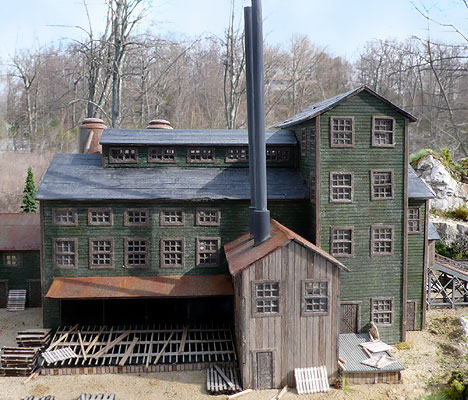
When working in the smaller scales, what do you see as the strengths and shortcomings as opposed to the larger scale work?
I do tend to build many models for myself in Z but my work with clients has led me to work in all the scales. I recently built an S scale farmhouse and garage; it was great to work with “real” lumber! I was able to use weathering techniques that weren’t as much a caricature as I really “weathered” the parts, and the results were gratifying. Nail holes and knots that really were nail holes and knots! If you’re putting a window shade in an O scale house, you’d better have the pull cord or it too will be a mere caricature instead of a scale model built with pride.
The smaller scale kits, by sheer virtue of their size, need to exclude some of the detail work the larger scale kits contain. In what areas overall would you like to see Z scale kits improve?
I’m lucky to do kit reviews for Ztrack magazine so I see a lot of kits first-hand. The proliferation of the laser and the marketing aspect of the Internet have really democratized kit manufacture. Many passionate people are making their own kits and each can add creativity and diversity to the hobby. Perhaps my eyesight is failing but I have no beef with the level of detail that so many kits contain! Animek’s “Billy’s House” has intentionally missing siding, Paw of a Bear has gorgeous details throughout, Micron Art’s kits have a Borzoi dog, GCLaser has a posable Bilco basement hatch, Miller Engineering (a pioneer in Z structures) has phone booths and picnic tables… what are we missing? Hammers?
I’m not skirting the question but I see the biggest “problem” in Z kits today to be that not enough people are building ’em! I personally know several manufacturers who eschew Z because they know in advance that not enough folks will buy and build their Z kit. These manufacturers are often individuals, not factories, and would be happy to sell a few dozen kits to make it a go. This is an unfortunate reality and I wish I had a solution.
One of the big questions in model kit finishing… brush or airbrush?
Blondes or brunettes, you ask? I rarely use an airbrush but, and I hope this is not too self-aggrandizing; I can really control an aerosol can which gives me almost everything I need from an atomized spray of color. With dry-brushing (essential!), thin washes of dilute pigment and my favorite (albeit expensive) Tamiya aerosols and I’m happy. I have a few airbrushes and favor the Aztek line. If you’re weathering a loco or Z boxcar however an airbrush can be your best friend, just always wear a respirator.
Your work has a very organic, natural feel that adds to the overall realism of your builds. It’s a big topic but could you give us a few thoughts on your use of color?
When in doubt, pick the lighter color. I laugh at the specific “accurate” locomotive colors for example, as the indoor lighting we use has no connection whatsoever to what you see in the real world in natural light. When I do layering of several colors, I pick analogous ones rather than wildly different hues and I usually work from dark to light when I’m layering paints. One of my shortcomings is I don’t do enough plain white buildings, which are the norm here in New England. Observe nature.
If you had to list one or two things for kit builders to keep in mind to improve their finished results, what would they be?
Be more subtle. Using a deep red intense paint with a bright white trim on a barn would look “real” in nature for about two weeks. The ravages of time, UV radiation and weather would fade most colors quickly. Add a little white to your bright colors. Never use pure black unless it’s the inside of a chimney and try building a couple of models where you avoid using the color direct from the bottle. Mitigate it with its complementary (opposite) color, thin the paints, put a wash of a different color over the base coat. Now, I am in love with weathering so I’m clearly prejudiced, but give “muting” a try. At the least, you’ll add variety to your layout by altering your usual methods.
Do you have any general rules of thumb you could share with our readers when working in the smaller scales?
Work in a brightly lit comfortable workspace and get an Aeron chair or a much less-extravagant knock-off.
When building kits keep warping in mind. I find warping just as prevalent in the large models, so over-brace your walls, employ squares and right angle tools. A building that’s not square, even just a tiny bit, is painful to look at. Thin your glues or use glue as sparingly as possible and don’t forget to have fun.
You can contact Bob via email.
Category: Raildig Guest




